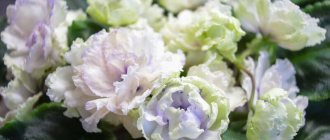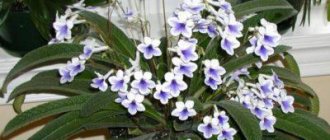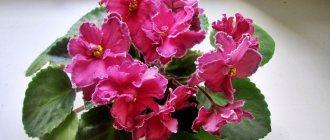Violet is an unpretentious plant that, with proper care, pleases with delicate and lush flowering all year round . But not all gardeners can grow and achieve lush flowering.
The secret to lush flowering is simple - you need to know what mistakes should not be made when growing Zivay violets.
Read the recommendations for caring for the Moreva Zivay variety and following them, the violet will thank you for your care with an attractive openwork flowering dense cap.
Violet Zivay (K. Morev)
Beautiful violet Zivay Moreva.
History of the variety
Variety Zivay is an Uzambara violet , which belongs to the Gesneriev family. It is the selection work of Konstantin Morev. Variety 2006.
Description and photo
Violet flowers:
- Large or medium size;
- Heavily terry;
- Coral-salmon color;
- The edges of the petals are fringed.
The saturation of flowering varies from light to darker and more saturated , depending on the temperature in the room. It blooms for a long time, about three months.
The pompom flowers are complemented by the beautiful and bright variegation of the rosette. The socket is standard in size. On average about 35 cm in diameter. There are many buds, an abundant, dense cap. You can see a photo of the Zivai Morev violet on the right.
Variegation, imprints
A variety with very bright and beautiful variegation. The pink-beige, sometimes tricolor variegation on the dark green leaves captivates the eye . Neat violet rosette:
- The central part is beige;
- Next with pink;
- And the outermost oldest leaves have white variegation.
The rosette of the variety is quite large, the leaves often turn inward .
Attention! With temperature fluctuations and the influence of other factors, the leaves of the variety can become almost white.
The violet leaves have an unusual color.
Sports
The variety sports and loses its variegated foliage . Sometimes, instead of chic salmon pompoms, inconspicuous white inflorescences with a bluish tint appear.
Reviews
Yana Ilyinichna. “ I think that the variety “Stars of Crimea” is a great find for flower growers dealing with fancy violets. Of course, violets can sometimes become sporty specimens, but to have the reflections of the southern night sky on the windowsill at any time of the day is a real miracle!”
This variety attracts gardeners with its interesting color.
Home care
Saintpaulias are capricious plants. For them you need :
- Find the right place;
- Or create suitable conditions in the house for growing them.
Otherwise, under unfavorable conditions, the purchased violet variety Zivay will not take root and will die .
You need to keep an eye on:
- Daylight hours;
- Room temperature.
Then the varietal violet will thank you with lush and abundant flowering .
Proper watering and fertilizing
Water the violet with settled water at room temperature . So that salts do not settle on top of the ground, which will not allow the delicate roots of Saintpaulia to receive normal nutrition.
The earthen ball should always be moist; the soil should not be allowed to dry out , but the top layer should dry out a little. Excessive and unreasonable watering of violets will lead to the formation of root rot, which can provoke the rapid death of the entire plant.
Fertilizing is carried out regularly , during active growth and flowering of violets, and during the dormant period, liquid fertilizing is added to the water for irrigation once every two weeks.
Violets require proper watering.
Advice! In order for the variegation of the Zivai rosette and flowering to be spectacular, violet growers use fertilizer with a high phosphorus content.
When the soil is waterlogged, the variegated variety does not recover as easily as others . Its leaves become covered with brown spots, and the variety can quickly die if excessive moisture stagnates.
Lighting and temperature
For the normal development of children and the growth of an adult rosette, the duration of daylight should be at least 10-12 hours.
The Morevsky variety Zivay, like all variegated varieties, does not like high temperatures; the optimal temperature for it is considered to be 18-22 degrees .
The variety does not like bright sunlight, nor does it like too high temperatures. When exceeding which at the socket :
- The center thickens;
- She stops growing;
- And it can even dry out the resulting buds.
In cool conditions, the Zivay variety feels excellent . The freshness of the flowering remains for at least three weeks.
Air humidity
In winter or summer, violets may suffer from insufficient air humidity . The optimal figure is considered to be 50-60%. Automatic humidifiers are used to increase indoor humidity. Can be used:
Growing Saintpaulia requires moist air.
- Decorative containers with water;
- Or place the pots on trays with wet: Moss;
- Or expanded clay.
What kind of soil does he prefer?
They buy special soil for Saintpaulias. It must be well breathable; for this purpose, baking powder is added to it.
Leavening agents:
- Vermiculite;
- Perlite;
- Foam balls;
- Sphagnum moss.
You can prepare your own soil for Saintpaulia.
Important! Disintegrants are needed so that the soil does not become compressed and the delicate roots of the violet receive enough oxygen.
To prepare the substrate, take 1 part of a baking powder, for example perlite, and mix it with 2 parts of Saintpaulia soil. If the violet grows on wick watering, then even more baking powder is added to the substrate in a 1:1 ratio.
Pruning and hygiene
As the green mass on the rosette grows, juvenile, all asymmetrical and damaged leaves . The stepsons that appear in the sinuses must be removed, otherwise the rosette will grow crooked.
Attention! The variety forms well on its own, so by immediately correctly forming a young plant in the future, an adult rosette will not bring much trouble.
Reproduction methods
Varietal violets are propagated in three ways :
- Rooting a cutting (leaf);
- Stepchildren;
- Rooting the peduncle.
Violet is most often . To preserve the maternal properties of the plant, it is better not to take too old or young leaves for cuttings.
A cutting from the second row is best suited . If the violet is blooming at this time, it is better to choose a cutting from the most beautiful flower that has good doubleness.
Transplant rules, rejuvenation
Grown-up children are transplanted using the transshipment method into a new larger pot when the roots become crowded. But, you should not immediately plant the rosette in a pot that is too large:
- The diameter of the pot should be smaller;
- And the violet leaves should be 2/3 larger than its diameter.
Adult violets that are several years old undergo a re-rooting procedure :
- Trim the elongated bare stem;
- Remove the lower tier of leaves;
- And they are planted in a new substrate in a greenhouse.
The violet needs to be replanted once a year.
After new roots have formed, the plant is taken out of the greenhouse and placed in its usual place .
About possible diseases and pests of violet RS Ballerina
To prevent attacks by pests and various diseases, you should not forget about preventive measures. And they start from the ground: before planting the plant, they heat the soil mixture in the oven and treat it with potassium permanganate. Regularly carefully inspect the plant so as not to miss the symptoms of diseases and apply this or that medicinal drug in a timely manner.
Let's talk about the most common problems with the Ballerina violet variety.
- Root rot occurs in the root system, causing the plant to become dull and inelastic. Once the leaves begin to turn yellow, they will soon begin to fall off. Without wasting time, remove the plant from the ground and inspect the roots. For treatment, spraying with a solution of “Fitosporin-M” in a ratio of 1.5 g / 1 l is necessary. water. The treated plant should be planted in a clean pot with new soil mixture.
- When attacked by a scale insect, the plant is covered with a gray-brown shield. If signs of this dangerous pest are found, the RS Ballerina violet is transferred to a new place and treated with Topsin-M.
- When attacked by thrips and aphids, the plant dries out before our eyes, as this pest drinks all its juice. In this case, the Ballerina’s salvation lies in using “Agravertine” according to the instructions.
- Gray rot is recognized by a gray fluffy coating on the Ballerina violet. They are treated with Topsin-M.
Features of flowering, growth and reproduction
How long does it take to grow an adult plant?
The variety grows quickly. Cuttings of the variety take root well, babies appear within a month and, under good conditions, quickly increase green mass. The first flowering can be seen after 7 months .
Features of flowering in hot and cool conditions
The variegated variety prefers cool conditions . At high temperatures in the room, the beautiful, three-color variegation of the leaves practically disappears.
When strong variegation appears, the rosette begins to lose symmetry and the flowers on it look a little sloppy . On old rosettes this effect increases even more, so this variety is rejuvenated every two years.
What do flower stalks look like?
The peduncles of the variety are erect, and may be slightly adjacent under the weight of three or four buds .
Is it possible to achieve cap flowering?
If you follow all the rules for caring for the variety, it is easy to achieve dense cap flowering from an adult rosette.
Bud lifespan
The buds formed on the peduncles take about a month to open . But the freshness of flowering remains for a long time. Under cool growing conditions, violets bloom for about 3 months.
The variety blooms for up to 3 months.
Persistent cap flowering makes an indelible impression , and complements them with delight from the beautiful variegated foliage. Which hugs delicate salmon pompom buds.
Breeder N. Puminova
Today Natalya Alexandrovna is a famous violet breeder. She even has her own trademark - the prefix “YAN”, by which you can immediately recognize the hand of the master - Natalya Aleksandrovna Puminova. Where does this nameplate come from? It turns out that the prefix appeared in honor of Yannick’s beloved dog! Here it immediately becomes clear that the talented and demanding breeder has a sense of humor, positivity, and creativity, and everything is in order. Yes, a talented person is talented in everything.
And this hobby began a long time ago, back in 1956. She first saw blue and white violets on the window sill in the library; they struck her with their sophistication and beauty. So this incident determined the fate of the future successful breeder; from that time on, violets became not only her favorite hobby, but also her life’s work. “Since then, my violets have always grown,” recalls Natalya Alexandrovna.
Description of the variety
Violet Blue-Eyed Russia has a standard socket. It has large double and semi-double flowers of a delicate blue color with elongated, slightly wavy petals. The edges of the petals are outlined with a purple edging. In the center there is a beautiful rich blue shading, and the edge has a strawberry frame - a border with a splash.
The rosette is green, exhibition. The leaves are pointed and grow slowly. The bushes are perfectly formed, they turn out beautiful, even, and compact. The size of the rosette depends on the size of the pot.
Violet Blue-Eyed Russia is a repeated winner of domestic exhibitions. The color and shape of the flowers is simply unique. The purple edging and expressive shades add elegance to the variety. Flowering under a lamp and under natural light is almost the same. However, in natural light the flowers are brighter and the flower stalks last longer in the bouquet.
Pot
For any plant it is necessary to choose the right pot. And violet is no exception in this regard. These plants are capricious. If the diameter of the pot is not selected correctly, the flower will not be able to develop or bloom normally.
Violets have a small root system and do not need much space. The pot should be three times smaller than the rosette. You cannot use the pot “for growth”, as in this case it may rot. If you use a pot that is too large, the plant will not bloom until its roots have covered the entire soil.
You can use hanging flower pots, as well as ordinary ones, with a diameter of 8-12 cm. Violets feel comfortable in such pots.











